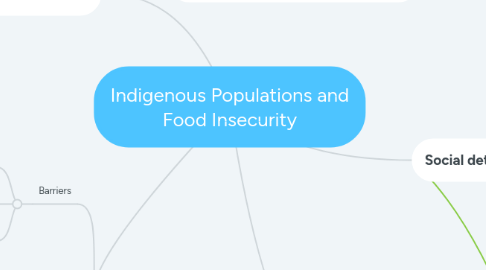
1. Causes
1.1. Barriers
1.1.1. Distance
1.1.1.1. Remote communities
1.1.2. Money
1.1.2.1. High cost of harvesting/shipping food to remote communities²
1.1.3. Time
1.1.3.1. Obtaining and preparing food¹
1.2. Erosion of Indigenous knowledge¹
1.2.1. Traditional foods replaced by market convenience foods¹
1.2.1.1. Convenience foods high in fats, sugar, sodium, low in micronutrients¹
1.2.1.2. Traditional foods tend to be healthier, more nutrient dense¹
1.3. Climate change³
1.4. Environmental disposession¹
1.4.1. Colonization
1.5. Reduced access to traditional land, waters, food resources¹
1.6. Environmental pollution³
1.6.1. Contaminants in meats, fish
2. Adverse health outcomes¹
2.1. Increased reliance on health care system
2.2. Heart disease
2.3. Depression
2.4. Obesity
2.5. Type 2 diabetes
3. Food insecurity: Physical and economic inability to access sufficient, safe, and nutritious food to meet diatary meeds and food preferences for an active and healthy life.⁴
4. Social determinants of health¹
4.1. Unemployment
4.1.1. Food insecurity highest in those permanently unable to work¹
4.2. Low income
4.2.1. Lowest income quintile 30x more likely to experience food insecurity than highest income quintile¹
4.3. Low education
4.3.1. Greatest food insecurity in households with less than high school education¹
4.4. Geographical location
4.4.1. Proximity to grocery stores
4.5. Household composition
4.5.1. Families with children more likely to experience food insecurity³
4.5.2. Female lone parents more vulnerable to food insecurity¹
